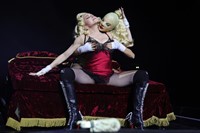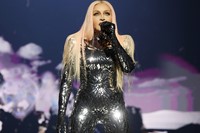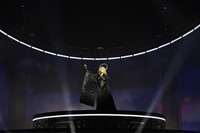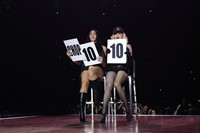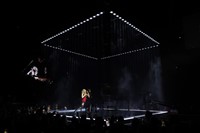As Madonna’s dazzling Celebration Tour arrives in London, we speak to the creative director enlisted to set the tone of the shows
“To age is a sin,” Madonna’s voice booms to the audience one night in London on her Celebration Tour, nearing the end of a two-hour retrospective show. “I think the most controversial thing I’ve done is to stick around.” A lot has happened in the performer’s 40-year-long career. Reinvention after reinvention, there’s been music, movies, books, theatre, scandals, fallouts, family, ageism, sexism, rock bottoms and career peaks – but “stick around” she has. For the Queen of Pop, building a retrospective world tour was never going to be a small feat, but it was a challenge that a then 27-year-old creative director for the stage, Lewis James, accepted in October last year. A year later, following London’s final arena show at the O2 – the first of 78 shows across 15 countries – he’s finally enjoying some respite.
By now, James is well adjusted to the hectic schedule of touring. Much of his graphic design course at Central Saint Martins in 2016 was spent helping to design a tour for Drake. “I got emails in my inbox saying ‘your lack of attendance is causing some concern.’ I was like ‘OK, well I’m in Arena in Texas’,” he laughs. Speaking over a Zoom from a hotel room in London, he leafs through a few notepads to show his early stage design sketches, reminiscing about a time before the preparation for Madonna’s world tour took over his day-to-day life. “Madonna went to see a [Post Malone] show of mine last year in New York, and a few days later, her management reached out to say hey. A couple of days later they asked if I could fly to New York. In the space of four days I was on Madonna’s sofa, chatting about the show,” James remembers. “I think she saw something in the show that she really liked, and we started the relationship from there. Post Malone is a fun artist to work with, but completely the opposite of Madonna.” And what of Madonna’s approach? “Madonna is extremely involved in the process, which is amazing. She has a lot of conviction in her ideas, and she knows what she wants.”
Dominating UK headlines for a good few days, the show was a staggering feat that contextualised the performer’s ascent to global stardom. Glaring in the frigid face of taboo, Madonna’s career is in part built upon sexuality. Remember when the Vatican denounced her pornographic Sex photo book as “morally deplorable”? Yet enacting these same expressions as a 65-year-old performer confirms there’s no end in sight for her provocations; these same challenging themes are not only acknowledged, they’re fearlessly embraced. “She’s iconic. There’s so many moments in history that she’s helped catalyse,” says James. “The historic relevance of this artist is something that I hadn’t worked with before. It is a really important story to try and tell.” And where better to begin to tell this story than at the beginning?
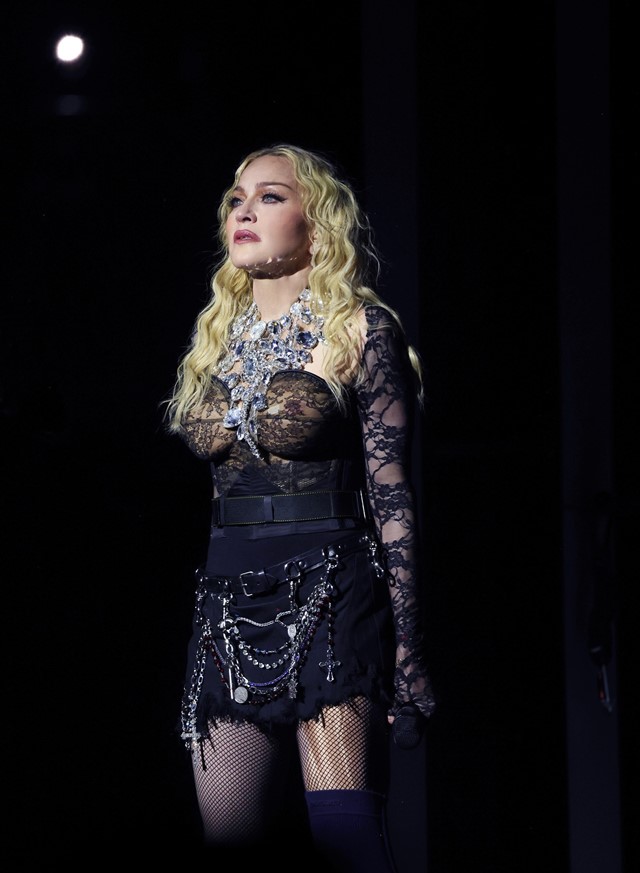
RuPaul’s Drag Race winner Bob the Drag Queen opens as the show’s MC, dressed in full Marie Antoinette crinoline regalia, handing Madonna 35 dollars – a reference to the performer’s arrival in New York City with $35 in her back pocket. “There’s so many little Easter eggs that are littered throughout the show that fans would hopefully recognise the second time around, if they didn’t notice it the first time,” says James. The stage itself, designed by leading entertainment architecture company Stufish (whose clients include Beyoncé, Blackpink and U2, to name a few), is a walking timeline split into five sections that jut into the audience at various avenues, reimagining the geography of Manhattan, where it all began. At the show’s centre, a three-layered circular central stage named, “the ‘clock’, or ‘the cake’ as it was first called, which is a reference back to her [1984] MTV performance,” says James. “That in itself naturally formed into this clock we were using to always tell the time, this ellipse of light at the start for [the show’s opening song] Nothing Really Matters. There’s a circularity there.”
More Easter eggs appear, like references to the bed in her documentary film Truth or Dare, which manifest in a particular erotic moment when Madonna writhes on a bed wearing a satin slip, as a lookalike donning a latex gimp suit caresses her body. In another moment, Bob the Drag Queen plays a bouncer at Paradise Garage, the club where Madonna used to party in her NYC infancy. “You’ve just gotta have to put your head into the space of a superfan when you’re creating a show that is all about her history,” says James. “Of course, her apparition appears throughout the show with this mask. [We had] talked about how the past felt like a sort of a dream. I think being able to interact with yourself on stage is an interesting concept. You could show a video, but that feels very literal. So we thought of a way to be figurative about it. It brings so much more having a person there on stage.”
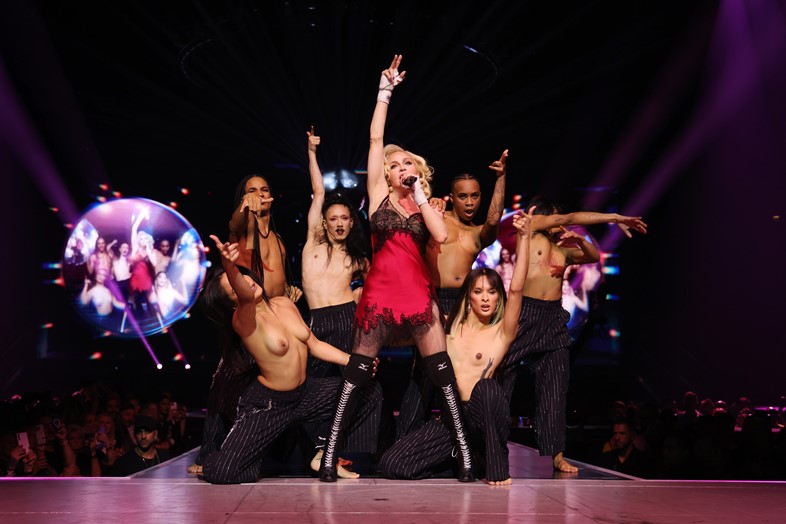
Weaving in her history with her present as a mother, her children were invited for the ride with their own dedicated performances. “That aspect came from Madonna herself. The show really is about family, and not just her family, but the fans.” Esther shows off her chops as a DJ and vogue performer, while Mercy plays piano to a ballad, and David plays guitar throughout. Her family of fans truly came in troupes, selling out most of the arenas in mere minutes, and James ensures everybody present gets a slice of the action. “It’s a totally different experience depending where you sit. When you’re in the pit, you feel the music, you feel the bass. But then from afar, it was important to heavily weave the camera work into the show so that people can understand it and feel it. For the people in the bowl, it’s quite panoramic.” A window frame lifts the singer over the audience in a spectacular feat of engineering that ensures all attendees enjoy the celebration.
Through his signature use of light and atmosphere, James’ tone of voice reveals itself. “I like to create shows that feel like you can explain them in one photograph, that’s what excites me. We’re really creating these small spaces and then large spaces with the lighting: with her performance of CBGB’s [the once iconic music club] the idea was to make it really small, and then with Bitch I’m Madonna where it all gets crazy and exciting, we really open it up,” he says. More than just a biography, the show is a dazzling continuation of her legacy, utilising slick stage design to tell the audience who she once was, and who she is today. “The music is the history. So in a way it was quite straightforward to sort of pull out these ideas and create figurative extensions of them.” With performances of Into the Groove, Justify My Love, Hung Up, and even Don’t Cry For Me Argentina, the show shapeshifts through the icon’s own iterations on a journey through her greatest hits, and it’s a legacy worth celebrating. “I’d like people to come away feeling like they’ve experienced the story and understood it,“ says James. “But again, I tell people to go to the show really open-minded. It’s not like other tours that Madonna’s done. It’s not trying to prove anything.”

